The brachioradialis is one of the muscles comprising the forearm’s posterior compartment.
Training the brachioradialis is essential for building bigger forearms and doing powerful pulling movements like chin-ups and rows.
Having bigger, stronger forearms can give you confidence and convey a sense of athleticism and strength.
It’s quite simple: if you want your brachioradialis to grow and get a vast, defined, and vascular forearm, then you need to curl your palms down. Or, if you just can’t bear to reduce your bicep stimulation, do hammer curls.
Here, I will share with you the 10 best brachioradialis exercises (based on science and experience) that will help you build a bigger forearm.
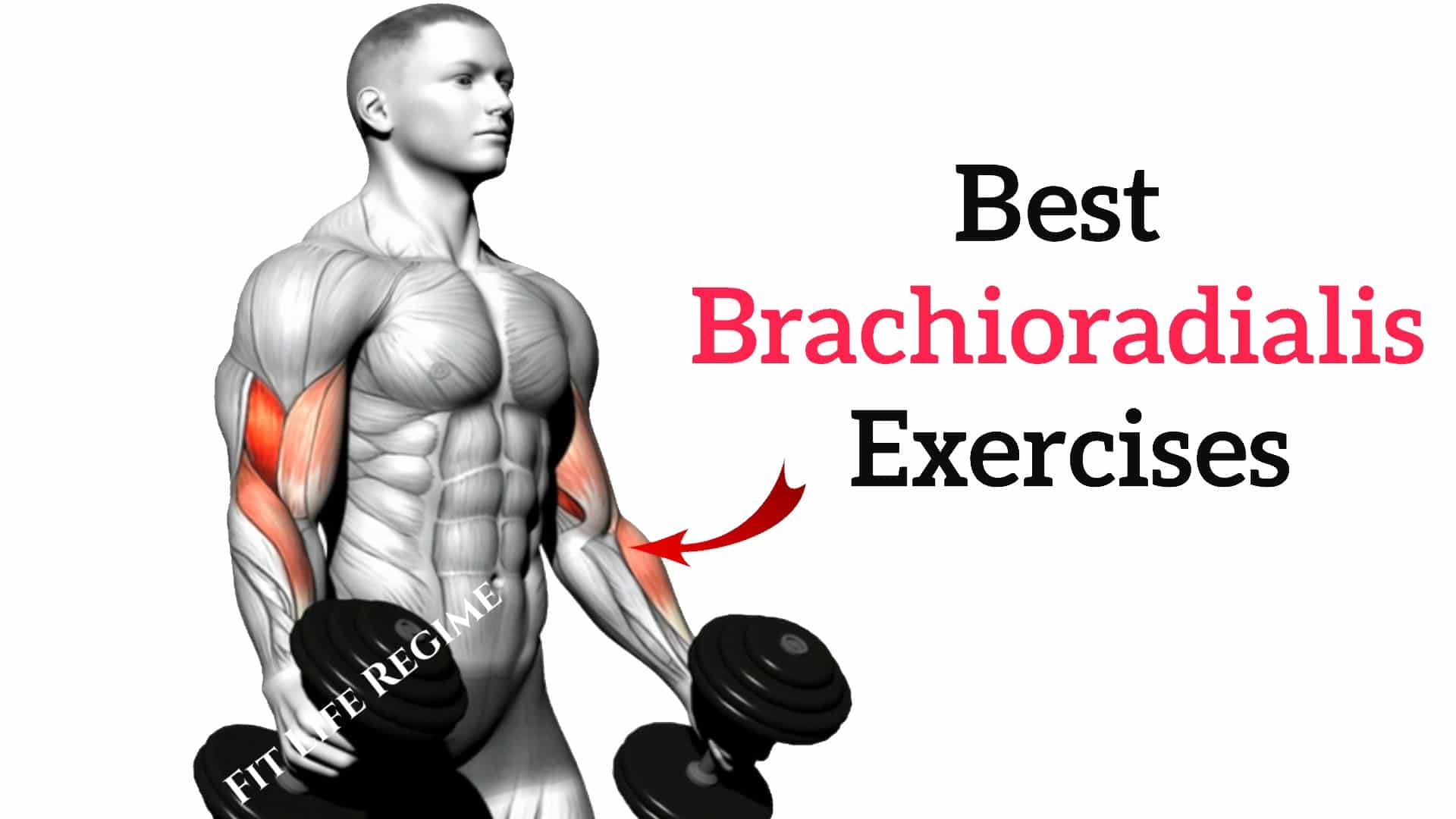
- How To Train The Brachioradialis Muscle
- Note:
- 10 Best Brachioradialis Exercises
- 1. Barbell Reverse Curl
- 2. Hammer Curl
- 3. Zottman Curl
- 4. Dumbbell Reverse Curl
- 5. Dumbbell reverse-grip concentration curl
- 6. Dumbbell Hammer Preacher Curl
- 7. Dumbbell Reverse Preacher Curl
- 8. Cable Reverse Curl
- 9. Cable Hammer Curl
- 9. Pull Up
- 10. Bent Over Barbell Row
- Brachioradialis Exercise Tips and Routines
- 1. Use Thumbless Grip
- 2. Curl Up With Full Range
- 3. Train With Slow Tempo, Moderate Weights, And High Reps
- Routine 1: Beginner Level
- Routine 2: Intermediate Level
- Routine 3: Advanced Level
- FAQs
- Do pull-ups work brachioradialis?
- Are Direct Brachioradialis Exercises Required For Forearm?
- Do I need to train brachioradialis?
- References
- 5 Best BRACHIORADIALIS EXERCISES To Build Bigger Forearm
How To Train The Brachioradialis Muscle
The brachioradialis originates on the humerus and inserts near the thumb side of the forearm, but it doesn’t cross the wrist joint. Because of this, it doesn’t participate in wrist flexion or extension like other forearm muscles.
Instead, its primary function is to assist with elbow flexion, which is why it’s not considered a traditional forearm muscle.
There are many exercises that focus on the brachioradialis, and you probably already know many of them, but perhaps you didn’t know that they are best for brachioradialis exercises.
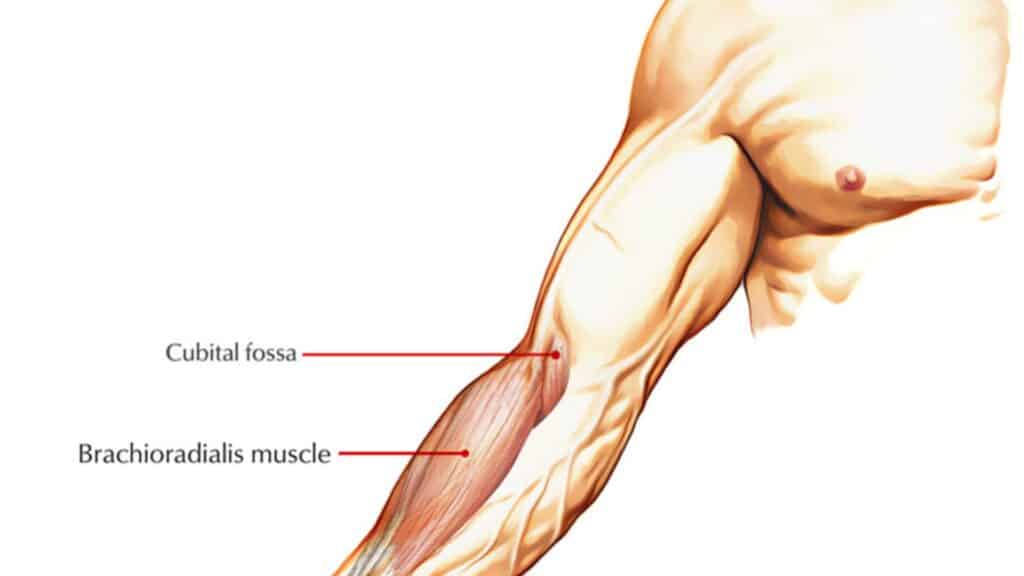
Four main techniques that will help you train the brachioradialis.
- Brachioradialis is most strongly recruited when you use a pronated or overhand grip (palms down).
- Use a neutral grip, aka hammer grip, it is probably best for recruiting the brachioradialis muscle.
- Use a thumbless grip, this is crucial for reverse curls, but it also applies for the other brachioradialis exercises, thumbless grip will set your brachioradialis on fire.
- Brachioradialis responds well to slower eccentric muscular contractions. As a rule of thumb, 2-5 seconds in the eccentric phase is a good place to start.
Note:
- A EMG study by Michael R. Boland found that contrary to the belief that neutral forearm position results in the strongest brachioradialis activation, the greatest EMG activity from the brachioradialis actually occurs during elbow flexion movements, regardless of forearm position.
- A study by Tim Kleiber found increased electromyographic (EMG) activity of the brachioradialis muscle during elbow flexion movements starting from a pronated forearm position. This indicates the brachioradialis is highly active as an elbow flexor when the forearm is pronated.
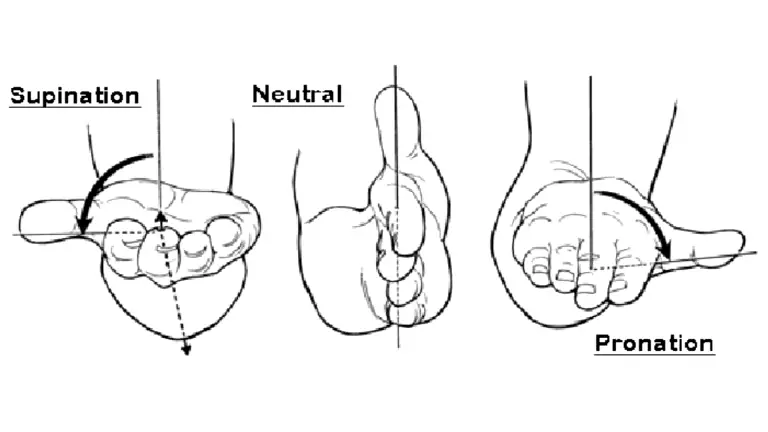
10 Best Brachioradialis Exercises
Take a look at the Brachioradialis exercises mentioned below, which will help you better understand how to work out the forearm.
1. Barbell Reverse Curl
The barbell reverse curl is a non-negotiable component of a barbell arm workout.
The reverse curl is a variation of the standard biceps curl except, instead of gripping the weight with the palms up (underhand grip), your palms are facing down (overhead grip).
The pronated grip you are using will engage the brachioradialis muscles, allowing you to move the weight during exercises.
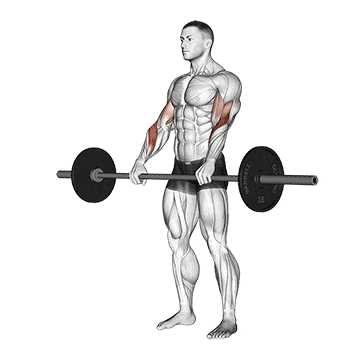
How To Do
- Grab the bar with a shoulder-width grip with your hands on top of the bar (pronated grip).
- Ensure that your elbows are kept close to your sides with your knees slightly bent, and your hands gripped tightly to the bar.
- Curl the bar up to shoulder level by bending your elbows.
- Your body should remain fixed. Only your biceps should be used to move the weight.
- Lower the bar back down to the arms’ extended position.
- Repeat for desired reps.
2. Hammer Curl
The Hammer curl is a classic weightlifting exercise that targets the biceps and forearms. It’s very similar to the biceps curl, with the only difference being the neutral (hammer) hand position. It is one of the best exercises that you can do to build your forearm and bicep muscles.
Hammer curls can be done in many different ways to keep your brachioradialis workout routine new and challenging. Try cable hammer curls and cross-body hammer curls.
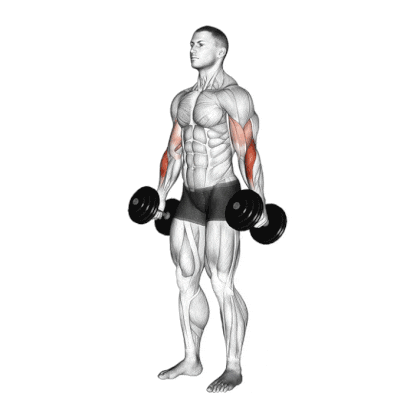
How To Do
- Stand upright with a dumbbell in each hand, with a neutral grip (thumbs around the handles with your palms facing your body).
- Position the dumbbells alongside your thighs with your elbows fully extended.
- Keep your elbows close to your torso and your upper arms stationary.
- Exhale and slowly curl the dumbbells upward by contracting your biceps until the dumbbell nears the front of your shoulder.
- Hold the contracted position for a moment and squeeze your biceps and forearms.
- Inhale and slowly lower the dumbbells back towards your starting position until the elbow(s) are fully extended.
3. Zottman Curl
The dumbbell zottman curl is another brachioradialis exercise that can help you correct muscle imbalances between your forearms.
Many people focus solely on traditional bicep exercises, such as the barbell curl, but the zottman curl offers a unique and highly effective way to target your biceps from a different angle.
Different hand positions on different parts of the lift.
- The first upward portion: the regular curl, focuses on bicep strength.
- The second lowering portion: the dumbbell reverse curl allows you to overload the brachioradialis.
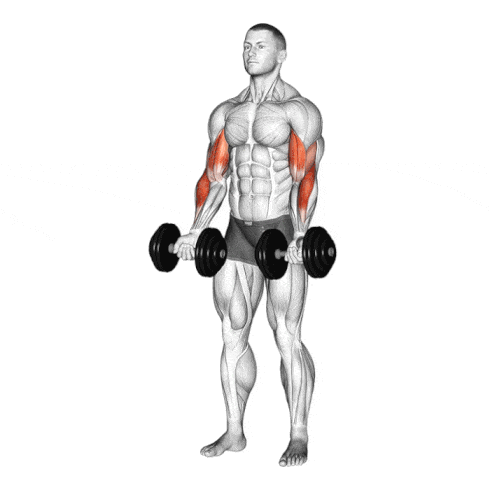
How To Do
- Hold a pair of dumbbells to your sides. Don’t go heavy. Choose a lighter weight and focus on perfecting your form.
- Keep your palms facing up as you curl the weights up to your shoulders. Pause at the top of the movement.
- Slowly rotate your grip so your palms are facing downwards.
- Lower the dumbbells slowly back to the starting position using an overhand grip.
- When the dumbbells are close to your thighs, again turn your hands while returning to the starting position.
4. Dumbbell Reverse Curl
The dumbbell reverse curl puts more direct strain on the brachioradialis than other reverse curl variations. This focused activation helps build both size and strength in this muscle.
Here’s a cool perk: as you get stronger, you can easily adjust the weight—no need to wait for a free barbell or mess with plates. Just grab the next size up and keep pushing yourself (BEST for drop set).
The motion is the same, but the change in grip allows for specific arm muscles to be targeted.
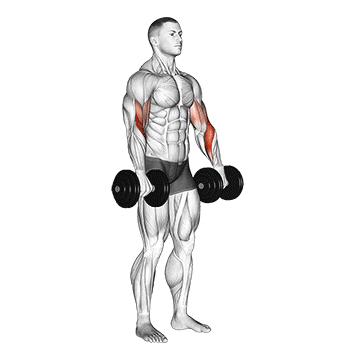
How To Do
- Stand straight, keeping your feet shoulder-width apart.
- Grab a dumbbell in each hand using an overhand grip, and arms should be fully extended.
- Keeping your upper arms stationary and your back straight, curl the weights up towards your shoulders and exhale as you do so. Use only your forearms for this movement.
- Continue curling the dumbbells until they are at shoulder level and your biceps are fully contracted.
- Return to the starting position in a smooth arc, and inhale as you do so.
5. Dumbbell reverse-grip concentration curl
This is the most popular type of curl, in which you grab the dumbbell with a reverse grip. This minimizes the involvement of other muscles and emphasizes your brachioradialis and biceps.
Since the reverse grip emphasizes the brachioradialis, you’ll notice improved forearm strength and definition over time.

How To Do
- Sit on a bench with your legs apart. Grab a dumbbell in one hand (say, the left hand).
- With your left arm almost fully extended, rest your elbow against the inside of your left thigh. Pronate your wrist so that your palm faces backward.
- Exhale as you curl the dumbbell up towards your shoulder. Hold and squeeze your biceps for a count of two.
- Inhale as you slowly lower the dumbbell to the starting position.
- Repeat with your right arm.
6. Dumbbell Hammer Preacher Curl
Discover the secret to stronger and bigger biceps with the preacher curl. This time-tested bicep blaster stands out among the many bicep workouts.
The dumbbell hammer preacher curl is a very effective exercise that targets the brachioradialis, brachialis, and bicep muscles.
Using a hammer/neutral grip targets more of the brachioradialis and brachialis than the biceps. It is a great variation of the preacher’s curl.
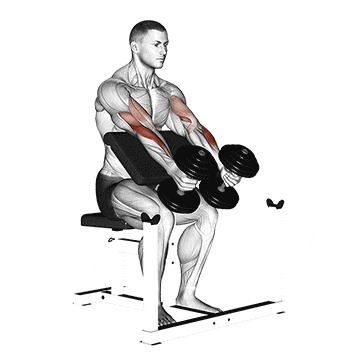
How To Do
- Adjust the preacher bench seat so that your arms are level with the top of the bench.
- Grab a dumbbell in each hand with a neutral/hammer grip and rest your arm against the bench with your arm extended fully down.
- Slowly curl the dumbbells up towards your head, keeping your arms on the bench at all times until you reach the top position.
- Hold for a count, squeeze and isolate your biceps.
7. Dumbbell Reverse Preacher Curl
It is a variation of the standard preacher curl in which you grab the dumbbell with a reverse grip, shifting the emphasis away from the biceps and placing it squarely on the brachioradialis.
Don’t be surprised if you can’t lift as heavy as you do with regular curls. This isn’t about ego-lifting. It’s about precision. Slow, controlled reps are your best friend here
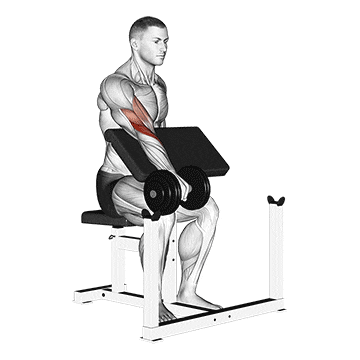
How To Do
- Adjust the preacher bench seat so that your arms are level with the top of the bench.
- Grab a dumbbell in each hand or one hand with a pronated (palms down) grip and rest your arm against the bench with your arm extended fully down.
- Keep your arms on the bench and slowly curl the dumbbell up towards your head until you reach the top position.
- Hold for a count, squeeze and isolate your biceps.
- Make sure that you perform the movement slowly with controlled repetition timing.
8. Cable Reverse Curl
The cable reverse curl is a variation of the traditional reverse curl that uses a cable machine instead of free weights. This exercise is fantastic for targeting both your biceps and forearms, particularly the brachioradialis.
As you start curling, you’ll notice something right away – constant tension. That’s the magic of cables, my friend. From the bottom of the movement all the way to the top, your forearms are under pressure.
You can easily change the angle by adjusting the cable height. High, low, middle – each one hits your brachioradialis slightly differently.
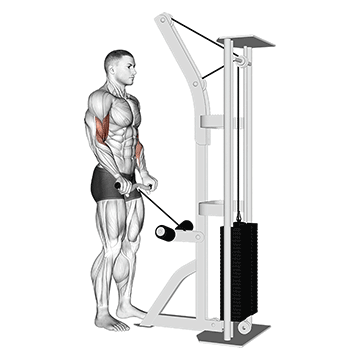
How To Do
- Stand up with your torso upright while holding a bar attachment that is attached to a low pulley using a pronated (palms down) and shoulder-width grip.
- Ensure that your elbows are kept close to your sides with your knees slightly bent, and your hands gripped tightly to the bar
- By flexing the elbow, raise the bar towards your chest.
- Contract the muscle and hold for a moment.
- Slowly lower the bar back down to the arms’ extended position.
9. Cable Hammer Curl
Dumbbell hammer curls are a classic. However, if you want to take your arm game to the next level, cable hammer curls are your ticket. They’re easier on your wrists and elbows, so you can probably curl more often without hurting them.
The cable hammer curl is a natural arm movement that can help activate muscles and reduce the risk of strain or injury.
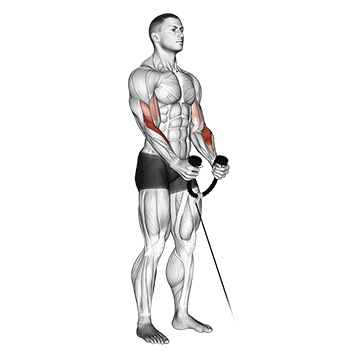
How To Do
- Attach a rope attachment to a low pulley and stand facing the machine.
- Grasp the rope with a neutral (palms-in) grip. Place your elbows by your side and keep them stationary during the entire movement.
- Pull your arms until your biceps touch your forearms. Hold for a second.
- Slowly, start to bring the weight back to the original position.
9. Pull Up
If you’re looking for a way to work your brachioradialis without weights, pull-ups are a great option. It is an upper-body strength movement that targets your back, chest, shoulders, and arms.
The close-grip pull-up is harder to perform than a standard pull-up because your hands will be close to the center of your body, which makes the exercise more challenging.
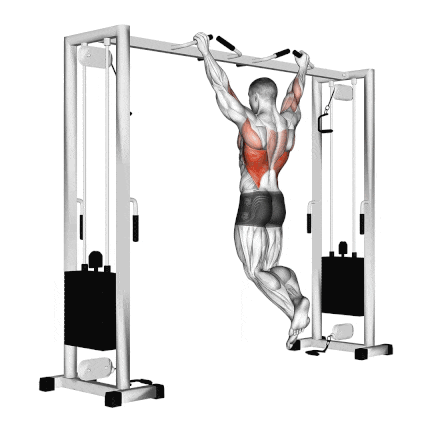
How To Do
- Using an overhand grip, grab onto a pull-up bar with your hands spaced narrower than shoulder-width apart.
- Hang from the bar with your arms fully extended and your chest high, while exaggerating the arch in your lower back.
- Pull yourself up by squeezing your shoulder blades together and contracting your lats until your chin passes the bar.
- Hold the contraction at the top for a second before slowly lowering yourself back to the starting position.
10. Bent Over Barbell Row
Barbell rows might not seem like the most obvious brachioradialis muscle exercise, but using an overhand grip can add a surprising amount of mass.
- Spacing your hands shoulder-width apart or closer targets the central inner section of the lats,
- whereas a wider grip targets the outer lats.
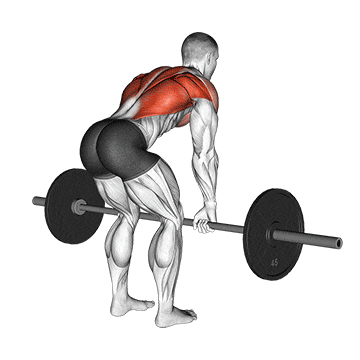
How To Do
- Stand with a shoulder-width stance and grab a bar with an overhand grip.
- Do not use more weight than you can handle. This fatigues your spinal erectors and says goodbye to form.
- Bend your torso forward at an angle of 45 degrees to the floor with the knees slightly, and let the bar hang in front of you.
- Now, use the back and raise the bar until it touches the abdominal region and not the chest region, as it reduces back muscle contraction.
- Slowly lower the bar under control to the starting position.
Brachioradialis Exercise Tips and Routines
Now you understand the technique of excellent brachioradialis exercises.
I found that using simple tips can bring quicker results. Here are three essential pieces of information for your brachioradialis exercise.
1. Use Thumbless Grip
This tip is essential for achieving proper form when performing reverse curls but it also applies to the other brachioradialis exercises.
Because your thumb does not support your weight, you will need the strongest muscle in your upper arm, the brachioradialis, to do the exercises.
2. Curl Up With Full Range
Many people stop reverse curls at 90 degrees, so their forearms don’t grow properly.
The brachioradialis is the most active at the top of the rep, which occurs at 90 degrees. If you do not perform full range of motion, then you will be depriving yourself of gains.
3. Train With Slow Tempo, Moderate Weights, And High Reps
The brachioradialis and forearm are mainly composed of durable muscle fibers. Training the forearm muscles involves a slow tempo, moderate weights, and high reps.
With this training, your forearms will become significantly muscular, defined, and vascular.
Routine 1: Beginner Level
| Exercise | Sets | Reps |
|---|---|---|
| Reverse Curls | 3 | 12-15 |
| Hammer Curls | 3 | 10-12 |
| Cable Reverse Curls | 3 | 12-15 |
Routine 2: Intermediate Level
| Exercise | Sets | Reps |
|---|---|---|
| Reverse Barbell Curls | 4 | 10-12 |
| Hammer Curl Variations (Alternating) | 4 | 10-12 per arm |
| Incline Dumbbell Hammer Curls | 3 | 10-12 |
| Cable Hammer Curl with Rope | 3 | 12-15 |
Routine 3: Advanced Level
| Exercise | Sets | Reps |
|---|---|---|
| Reverse Curl with EZ Bar | 4 | 8-10 |
| Seated Hammer Curls | 4 | 10-12 |
| High Cable Reverse Curls | 3 | 12-15 |
| Zottman Curls | 3 | 10-12 |
FAQs
Do pull-ups work brachioradialis?
Pull Up (overhand grip) will mainly work the brachioradialis, but your brachialis muscle also works quite a bit.
Are Direct Brachioradialis Exercises Required For Forearm?
Don’t worry about doing the brachioradialis exercise if you’re a beginner. It’s important to remember that whenever you curl your biceps or pull your back vertically or horizontally, especially when your hands are pronated, you already stimulate the brachioradialis.
If you still want to train your brachioradialis without complicating it, follow the abovementioned exercises.
Do I need to train brachioradialis?
If you already have a reasonable amount of training experience but find that your forearms are lacking in size, and you want to improve their development, then these brachioradialis exercises are for you.
Or if building bigger forearms is your specific goal, and you want to maximize your gains in that area fully.
As a general guideline, these exercises can be done 2-3 exercises 1-2 times per week for 2-3 sets of 8-10 reps each.
References
- Kleiber, T., Kunz, L., & Disselhorst-Klug, C. (2015). Muscular coordination of biceps brachii and brachioradialis in elbow flexion with respect to hand position. Frontiers in Physiology, 6, 215. https://doi.org/10.3389/fphys.2015.00215
- Boland, M. R., Spigelman, T., & Uhl, T. L. (2008). The function of brachioradialis. Journal of Hand Surgery (American Edition), 33(10), 1853-1859. https://doi.org/10.1016/j.jhsa.2008.07.019
5 Best BRACHIORADIALIS EXERCISES To Build Bigger Forearm

Manish is a NASM-certified fitness and nutrition coach with over 10 years of experience in weight lifting and fat loss fitness coaching. He specializes in gym-based training and has a lot of knowledge about exercise, lifting technique, biomechanics, and more.
Through “Fit Life Regime,” he generously shares the insights he’s gained over a decade in the field. His goal is to equip others with the knowledge to start their own fitness journey.

